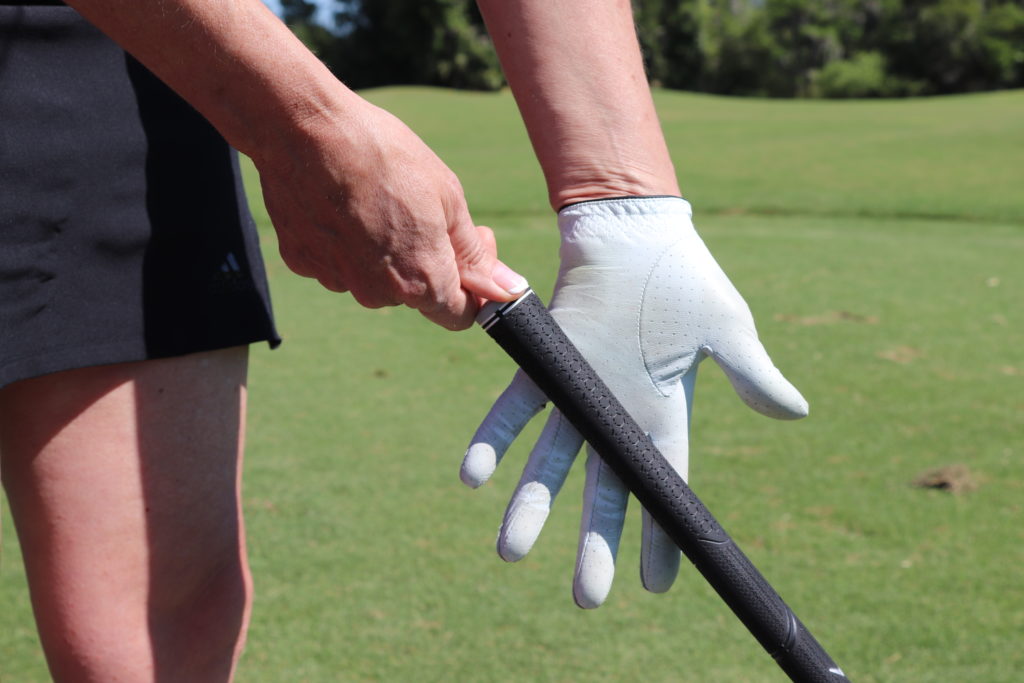Introduction
The Hidden Power of Grip Pressure
You can have the perfect stance, spot-on alignment, and a textbook swing — but if your grip pressure is off, you’re probably sabotaging your shot before you even swing. Yep, grip pressure is that important. And for women golfers, mastering it can unlock better control, more distance, and less tension across the board.
Why It Matters More Than You Think
Think of grip pressure like the volume knob on a radio. Too tight, and everything’s distorted. Too loose, and the signal’s weak. But get it just right? The sound (or in this case, your swing) is clear, smooth, and powerful.
Understanding Grip Pressure
What Is Grip Pressure?
Grip pressure is exactly what it sounds like — the amount of force you apply when holding the club. It’s not about squeezing the life out of the grip or letting it slip. It’s about finding that Goldilocks level of “just right.”
How Grip Pressure Impacts Your Swing
Too tight? Your arms and wrists tense up, restricting motion and robbing you of power. Too loose? You risk losing control of the club, especially on faster swings. Ideal grip pressure lets your wrists hinge naturally and helps you square the clubface consistently.
The Sweet Spot Between Loose and Tight
The magic number? Think 4 or 5 out of 10. Firm enough to control the club, but soft enough to allow freedom of movement. Like holding a tube of toothpaste — firm, but you’re not trying to make a mess.
Grip Pressure Differences Between Men and Women
Physical Strength vs. Technique
Men often rely on strength, which means they can get away with gripping harder. Women, on the other hand, thrive on technique. That’s a good thing — it means you’re more likely to benefit from proper grip pressure awareness.
Common Mistakes Women Make With Grip
Many women grip too tightly — especially with longer clubs or under pressure. This leads to tension in the shoulders, jerky swings, and poor contact.
Why Women Benefit From Finesse Over Force
When you ease up and let your technique shine, the clubhead moves more freely, and your timing improves. Grip pressure becomes a feel thing — not a strength thing.
Signs Your Grip Pressure Might Be Off
Pulls, Pushes, and Loss of Distance
If your shots are flying offline — especially hooks or blocks — grip tension might be to blame. Tight hands restrict your natural release.
Tension in the Forearms or Wrists
After a round, do your forearms feel tight? Do your wrists ache? That’s a red flag that you’re over-gripping.
Wear Marks on the Grip
Uneven or premature wear on certain parts of your grip means you’re squeezing too hard in specific spots.
How to Find Your Ideal Grip Pressure
The “Toothpaste Tube” Test
Hold a tube of toothpaste like a club. You want to grip it firmly enough that it won’t drop — but not so hard that any paste oozes out. That’s your baseline pressure.
The Club Wiggle Drill
Grip your club and waggle the head gently. If you can’t move the head, you’re holding on too tightly. If it flops around too much, you’re too loose.
Feedback From Impact and Feel
Pay attention to your shots. When do they feel effortless and crisp? That’s likely when your grip was just right.
Grip Pressure in Different Clubs
Driver vs. Wedges: Varying Your Grip
Your driver may call for slightly more pressure — say a 5/10 — to handle speed and length. Wedges? Think 3 or 4/10. The softer grip helps with feel and touch.
Adjusting Pressure Based on Club Length
Longer clubs = a bit more pressure. Shorter clubs = a lighter touch. Think of it as scaling up or down slightly depending on the club’s demands.
How Grip Pressure Affects Putting
This is where it really counts. Most putting yips come from tension. Try a grip pressure of 2 or 3/10 when you putt — light enough to feel the putter head swing.
The Role of Grip Size and Glove Fit
Oversized vs. Undersized Grips
Too thick, and you may overcompensate by gripping harder. Too small, and you’ll squeeze to keep control. Find a grip that fits your hand size — most women benefit from “undersized” or “ladies” grips.
How the Wrong Glove Can Lead to Tension
A stiff or poorly fitted glove can subconsciously make you grip tighter. Use a soft, snug glove that lets you feel the club naturally.
Finding the Perfect Fit for Smaller Hands
If you have petite hands, consider going even slimmer on grip diameter. A perfect fit gives you more control with less force.
Drills to Improve Grip Pressure Control
The Headcover Swing Drill
Place a headcover under each armpit and take slow swings. If one falls out, you’re likely tensing up. Focus on soft hands and smooth tempo.
The Soft Towel Grip Drill
Wrap a towel loosely around your grip and hit short pitches. You’ll be forced to hold lightly — otherwise the towel slips.
Practice Swings With Eyes Closed
This helps you tune into feel. Close your eyes, take a few slow swings, and focus only on your grip pressure and club movement.
Mental Game: Relaxation Equals Control
How Stress Tightens Your Grip
Pressure situations = physical tension. That tension usually shows up in your hands first. Staying loose mentally helps your grip stay light physically.
Breathing Techniques for Pre-Shot Routine
Take a deep breath before each shot. In through the nose, out through the mouth. It’s a cue to relax your grip and reset your mind.
Building Grip Awareness Through Mindfulness
Before each shot, ask yourself: “Am I gripping lightly?” Build that check-in into your pre-shot routine until it becomes second nature.
Instructor Tips: What the Pros Say
LPGA Coaches on Grip Pressure
LPGA instructors constantly preach “soft hands.” Many even recommend gripping softer than you think — especially with wedges and putters.
Common Fixes They Recommend for Women
- Use lighter grips
- Practice holding the club with thumb and forefinger only
- Take swings focusing purely on grip and rhythm
Why Lighter Pressure Often Equals More Power
It’s counterintuitive, but looser hands create better wrist hinge, a wider arc, and more clubhead speed — all key ingredients for more distance.
How Equipment Impacts Grip Pressure
Shaft Weight and Flex
A heavy or stiff shaft can make you grip tighter to control it. Women often do better with lighter, more flexible shafts that promote relaxed swings.
Clubhead Design and Feedback
Some clubheads offer more feel, which helps you know when your grip is right. Others are “muted” — and that can lead to guessing and gripping harder.
Choosing Grips That Enhance Feel
Go for soft, tacky grips with good feedback. These help you hold lighter without worrying about the club slipping.
Grip Pressure Through the Swing
Address vs. Takeaway vs. Impact
Grip pressure should stay consistent — not ramp up as you swing. You’re not trying to strangle the club at impact. Let the club do the work.
Keeping Pressure Consistent
Try to maintain the same pressure from address to finish. A constant grip promotes smoother transitions and better timing.
Avoiding the “Death Grip” on the Downswing
Many women tighten up right before impact. Stay mindful — if you’re trying to “hit hard,” you’re likely gripping too hard.
When to Re-Evaluate Your Grip
After Injury or Fatigue
If you’re recovering from wrist, elbow, or shoulder pain, check your grip pressure. Lightening it can ease strain and reduce flare-ups.
When Changing Equipment
New shafts, heads, or grips = new feel. Don’t assume your old grip pressure still works. Test and tweak it.
Seasonal Tune-Ups for Your Hands
Colder weather? You might grip harder without realizing it. Seasonal check-ins help you stay consistent year-round.
Final Thoughts on Grip Pressure for Women Golfers
Grip pressure isn’t flashy — but it might be the most underrated skill in your game. For women especially, mastering grip pressure creates freedom, consistency, and effortless power. It’s not about squeezing harder. It’s about holding smarter.
Conclusion
If you’re struggling with control, inconsistency, or fatigue in your swing, your grip pressure might be the silent saboteur. Adjusting it isn’t complicated — it’s about awareness, practice, and a willingness to feel instead of force. The best swings in golf aren’t built on tension. They’re built on rhythm, freedom, and a grip that’s firm… but never fearful. Let go a little — and watch your game take flight.
FAQs
1. How do I know if my grip pressure is too tight?
If your forearms tense up, your shots feel jerky, or your glove wears out fast — you’re likely gripping too tightly.
2. Should grip pressure change in the short game?
Yes! Use lighter pressure with wedges and putters to enhance feel and touch around the green.
3. Can grip pressure affect my swing speed?
Absolutely. A relaxed grip encourages faster clubhead speed and better energy transfer.
4. Do women need different grip training than men?
Not necessarily — but women often benefit more from drills that focus on feel, finesse, and soft hands.
5. What’s the best way to test grip pressure at home?
Try the toothpaste tube or towel drill. Both are simple, low-tech, and give instant feedback.









